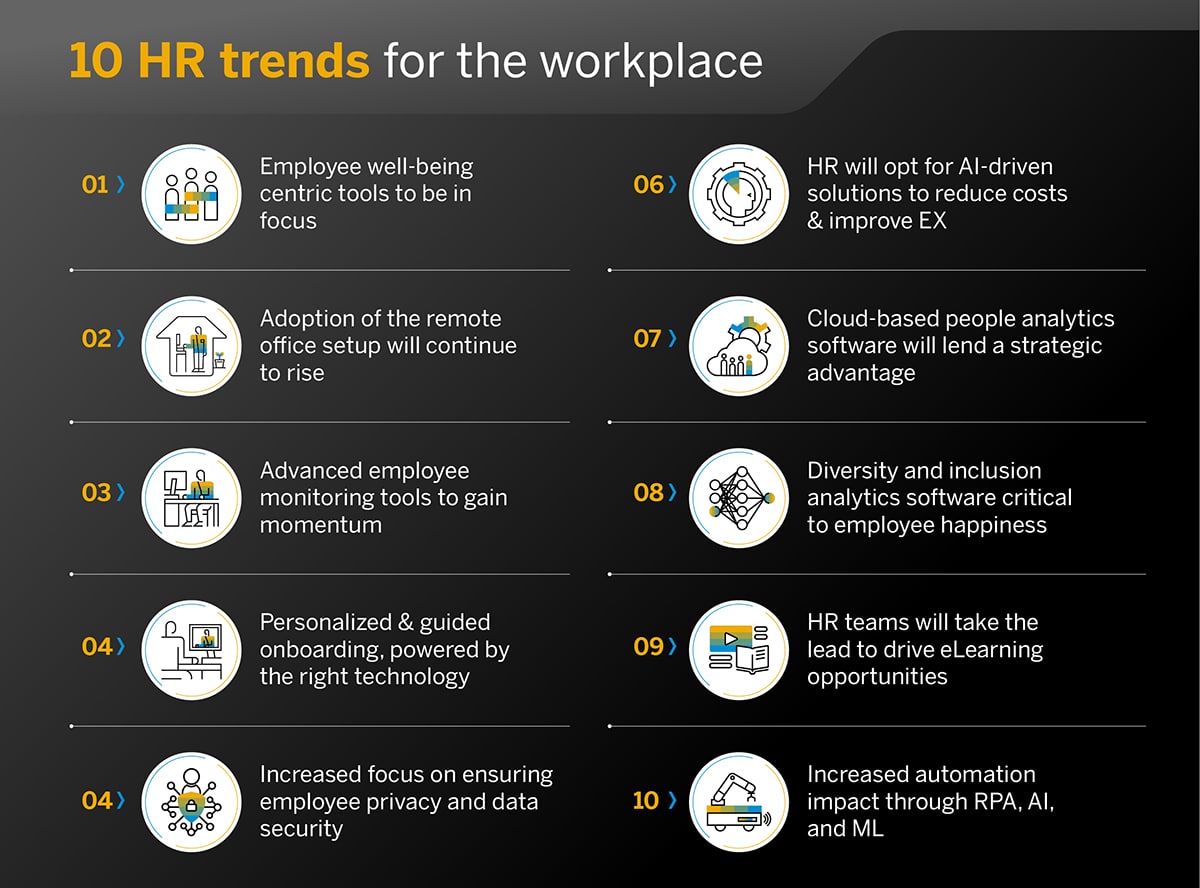The HR industry has undergone numerous changes in the previous few years. The rising desire for diversity in firms, the worldwide pandemic, and practices such as work-from-home have all influenced HR operations in the ‘new normal’. Implementing a cloud-based and digital HR software trends can help enterprises automate administrative operations and usher in a new wave of innovation. With HR operations now going digital to keep pace with evolving employee expectations, the department’s focus has shifted from reinvention to adding value.
From building on the learnings from the pandemic to placing the employee at the center of the workplace, certain trends are expected to dominate the HR landscape this year. Here are some of them:
Top 10 HR trends for the workplace (and how to make the most of it):
1. Employee well-being tools will be in focus
Employee well-being was a dominant subject all of last year. This year, employee-centric HR planning tools will be the topic of discussion. Organizations that want to promote themselves as employee-first will need to refocus their attention on driving well-being.
What’s important to note is that employee well-being has taken on a new meaning. It includes different aspects – from physical and emotional well-being to social and career wellness. By using the correct tools and platforms, HR can assist employees in having healthy work/life boundaries, being engaged and interested in their work, and feeling visible and appreciated. This is especially true in a virtual or hybrid work environment, where well-being aspects can’t be accurately assessed or handled without the use of technology.
The learning: HR professionals will have to rely on HR planning tools to cover all aspects of employee engagement. They need to strategize ways to combine employee engagement and virtual technology, while placing employee well-being at the center of every initiative.
2. Adoption of the remote office setup will continue to rise
According to research by Gartner, around 31% of all workers globally will be remote by 2022, a mix of hybrid and fully remote workers. If 2021 was any indication, this will drive higher adoption of remote-first technology (think: laptops, tablets, PCs, etc.) and social collaboration tools such as Microsoft Teams, Slack, etc even in 2022. This means that there should be greater emphasis on the remote work culture and its infrastructural requirements.
HR managers should manage employee expectations by providing the required tech devices for a remote work setup. They can also look at compensating employees or providing financial support to set up home workstations.
The learning: HR representatives will need to rethink their roles and understand how to leverage agile technology to:
- Create a sense of community among employees who now belong to a more diverse and geographically-dispersed workforce
- Build more integrated and virtually-driven workflows for the short and long-run
- Conduct impactful virtual training and drive virtual team-building activities
- Streamline business processes and optimize outcomes with the latest HR software
- Preserve the organization’s intrinsic culture without compromising on the employee needs, expectations, and requirements
3. Employee monitoring tools will trend
Though a somewhat tricky area, employee monitoring tools are gaining momentum. This is primarily because of remote work, which has driven rudimentary changes in communication. To gauge employee behavior and gather real-time employee feedback, HR managers are leveraging advanced employee monitoring tools. These tools help to track employee engagement while working from home. They can also throw light on important metrics such as website/app usage, time tracking, productivity tracking, sentiment analysis, and so on.
The learning: HR professionals need to double up as data experts to gather actionable insights from these tools. By converting these data-driven insights into patterns and habits, HR experts can prevent instances of employee burnout and low morale. They can also build customized training and development programs and boost employee productivity.
4. HR will be tasked with virtual onboarding
Virtual onboarding has emerged as a viable option for organizations. Even when offices reopen, virtual onboarding might be relevant for companies that opt for a hybrid workforce. The primary focus for organizations should be to build personalized and guided onboarding programs, powered by the right combination of technological tools. The secondary focus should be to drive peer-to-peer engagement as, according to a recent Capgemini report, “New joiners feel disengaged in a remote set-up and limited support left 54% of new joiners feeling confused and lost during their initial days with their company.”
Furthermore, “52% of them weren’t even aware of their organization’s values and benefits. These difficulties extended to existing employees, where 38% found it harder to collaborate virtually with new joiners.”
This is where using the right mix of tech tools can promote self-learning among employees. It helps them to ‘connect’ better with the organization and empowers recruits to be onboarded on the go.
Enterprises should ensure that the digital onboarding format is interactive. For inspiration, take a look at Deloitte’s interactive onboarding game, “The Chosen Analyst,” which gamified the onboarding process, making it fun and ‘flexible’ for the modern learner.
The learning: HR teams need to revisit their end-to-end virtual onboarding strategy and think about HR software that automates onboarding processes such as documentation. To improve the efficacy of such an onboarding program, they need to start by asking the following questions to recently onboarded employees:
- What kind of communication is being driven between the new hire and the company? Is it value-oriented and useful?
- Are the onboarding tools learning-oriented and do they provide the required levels of guidance?
- Is there quality peer-to-peer engagement?
- Can the new hire connect with the brand’s work culture, ethos, and values?
- Are the recruits being provided sufficient resources, tools, and support to advance their learning of the work and managerial expectations?
5. Employee (and company) data security will take the spotlight
Much has been written and spoken about the important role cybersecurity plays within organizations. With digital and remote work becoming the norm, there needs to be an increased focus on ensuring employee privacy and data security. After all, leaked personal data can hamper employee retention and cost enterprises dearly.
To cater to growing instances of data fraud, senior leadership from the HR and IT teams should collaborate to understand the kind of employee-centric cybersecurity tools to invest in.
The learning: The HR team should routinely partner with the organization’s IT team to:
- Brainstorm and map out the key policies required for setting up a robust data security framework and system in place
- Drive consistent additional training on how to use cybersecurity tools
- Chart out how to respond to a data breach crisis and communicate with employees to minimize harm
In the end, enterprises need to remember that HR technology cannot replace the ‘human touch.’ Any HR software or HR planning tool cannot be treated as a magic pill. It will not absolve HR professionals from their core responsibility–empowering people to make valuable contributions to their professional and personal lives. The need of the hour is to augment diverse HR activities with a strategic mix of technology and an employee-centric focus.
6. AI in HR will gain traction
Enterprises looking to transform HR functions in a modern way need to leverage the power of AI tools.
According to a Gartner survey, around 30% of respondent organizations will be using AI-based solutions in their HR functions this year.+

Reduced costs, improved employee experience, and enhanced decision-making are the top-three reasons why HR leaders will opt for AI-driven solutions. In terms of application, AI can benefit three core areas: basic HR operations, talent acquisition, and employee engagement monitoring.
The learning: The AI tools that organizations use – be it for employee development or HR functions – will only be as good as the people who use them. In other words, upskilling HR professionals with a ‘future lens’ to adapt to these AI tools will become a raging priority.
For instance, Big Data recruiting will be used to generate a 360-degree picture of the potential hire and boost the quality of hire. Without having a clear understanding of how the people analytics tool works, recruiters will not be able to source high-quality hires.
7. Cloud-based HR software and analytics will lend a strategic advantage
At the center of successful HR strategies lies real-time employee data. This is why cloud-based people analytics software solutions are gaining executive buy-in.
By leveraging analytics, HR leaders can drive timely and informed decision-making. It also contributes to boosting employee engagement, lowering employee churn rates, and reducing cost per hire.
Organizations will continue to invest in big data-powered analytics software to extract employee-centric and business-relevant insights to improve HR decision-making.
The learning: HR professionals need to be well-trained to make the best out of the people analytics software and drive greater ROI. They need to know about the right data input to extract actionable insights that reflect the business’ (and employees’) most pressing concerns.
To that end, HR professionals with a prior analytics background will gain the upper hand going forward as more and more organizations look towards building a data-driven work culture.
Finally, HR will benefit from the use of strategic, data-oriented HR software that can help in employee evaluation, boost hiring accuracy, and preempt employee turnover.
8. Knowledge of diversity and inclusion (D&I) analytics software will become instrumental to employee happiness
According to the Harvard Business Review, leveraging data in diversity and inclusion initiatives can:
- Encourage businesses to move beyond tick-the-box exercises and vanity metrics
- Empower HR professionals to understand where to make a headway with their D&I initiatives and where they are falling short
- Help identify blind spots within the HR systems and prevent employee turnover
The learning: The HR talent analytics team needs to pair up with the organization’s legal team to ensure that the enterprise is capturing the right data sets. It also gives insight into the efficacy of D&I efforts with accurately targeted, measurable, and accessible metrics. Both teams need to work together to achieve the diversity and inclusion goals instead of working in disjointed silos.
9. HR Teams will take the lead to drive eLearning opportunities
With the onset of remote working, eLearning adoption has skyrocketed. As expected, eLearning tools are mostly being used to upskill or reskill employees. They cover areas like such as product orientation, safety training, leadership and development, and so on.
Taking into account the Great Resignation of 2021 phenomenon, it is logical to assume that more and more people might need additional training to ‘make up’ for lost time and the inadvertent skills gap.
The learning: Forward-thinking HR managers need to focus on building comprehensive eLearning programs that provide content-rich and personalized courses. They should start by understanding which platforms to leverage and which topics to build the courses on.
Most importantly, they should focus on driving bite-sized content–also known as microlearning–to boost employee engagement and knowledge retention. Plus, video content format finds multiple takers within the organization and hence, must be promoted for all kinds of eLearning topics–be it for soft skills, technical skills, communication topics, corporate training, or even lifestyle and mental health topics.
10. Job automation through digital HR software
With the increasing automation through RPA, AI, and machine learning, HR managers must assess how automation trends impact the organization’s processes as well as employees’ confidence. While automation may boost productivity and reduce costs, it can lead to ‘job scares’ among employees. This is where the HR team can take charge and drive retraining and retooling activities.
The learning: To ensure that the enterprise retains quality employees and doesn’t lose them to job transitions as a result of automation, HR managers will need to redirect their energies towards building a creative, emotionally-intelligent, and highly adaptable workforce. This workforce should be able to work with agility and pivot as needed. More importantly, these human assets should be able to work in sync with AI-powered machines to provide organizations with the best of both worlds. When it comes to reskilling and upskilling employees for automation-related jobs, HR teams will have their work cut out for them.

The Final Word
The responsibilities of HR managers have transformed from simple hiring and appraisals to complex tasks such as shielding employees from burnout, planning the upskilling of the workforce, and so on. For such tasks in hand, they need digital assistance in the form of HR planning tools and HR software. Such tools can help the HR team keep pace with changing employee needs, and focus on building real connections an.



